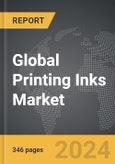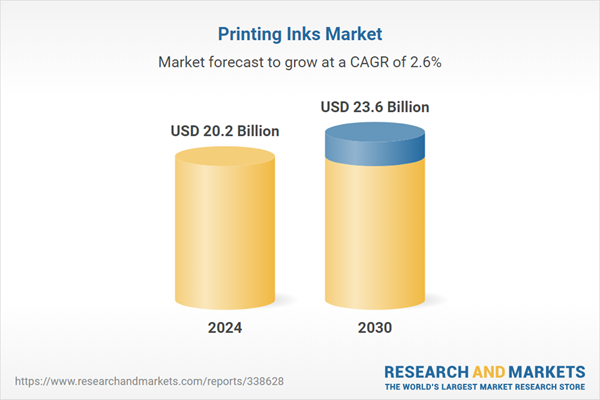The global market for Printing Inks was valued at US$20.2 Billion in 2024 and is projected to reach US$23.6 Billion by 2030, growing at a CAGR of 2.6% from 2024 to 2030. This comprehensive report provides an in-depth analysis of market trends, drivers, and forecasts, helping you make informed business decisions. The report includes the most recent global tariff developments and how they impact the Printing Inks market.
Segments: Formulation Type (Solvent-based, Water-based, Oil-based, Other Formulation Types); Product Type (Lithographic, Gravure, Flexographic, Digital, Letterpress, Other Product Types); Application (Label & Packaging, Commercial Printing, Publications, Other Applications).
Geographic Regions/Countries: World; United States; Canada; Japan; China; Europe (France; Germany; Italy; United Kingdom; Spain; Russia; and Rest of Europe); Asia-Pacific (Australia; India; South Korea; and Rest of Asia-Pacific); Latin America (Argentina; Brazil; Mexico; and Rest of Latin America); Middle East (Iran; Israel; Saudi Arabia; United Arab Emirates; and Rest of Middle East); and Africa.
The analysts continuously track trade developments worldwide, drawing insights from leading global economists and over 200 industry and policy institutions, including think tanks, trade organizations, and national economic advisory bodies. This intelligence is integrated into forecasting models to provide timely, data-driven analysis of emerging risks and opportunities.
Global Printing Inks Market - Key Trends and Drivers Summarized
How Have Printing Inks Evolved Over Time?
The history of printing inks is as colorful as the products themselves, stretching back to ancient civilizations that first experimented with natural dyes and pigments. The earliest inks, used by the Egyptians and Chinese, were made from soot and plant materials, giving rise to a rudimentary yet effective medium for communication and art. With the advent of the printing press in the 15th century, the demand for more sophisticated inks surged, leading to innovations in formulation and production. The 20th century marked significant advancements with the introduction of synthetic dyes and pigments, which offered greater consistency, vibrant colors, and enhanced durability. Today, printing inks have diversified to meet the needs of various applications, ranging from traditional book printing to complex digital and 3D printing technologies, reflecting an ongoing evolution driven by technological advancements and market demands.What Are the Key Components and Types of Printing Inks?
Printing inks are composed of four primary components: pigments, binders, solvents, and additives. Pigments provide the color, which can be either organic or inorganic. Binders, such as resins, help pigments adhere to the printing surface, while solvents control the viscosity and drying speed of the ink. Additives are used to impart specific properties like gloss, resistance to UV light, or improved flow. The major types of printing inks include lithographic (offset) inks, flexographic inks, gravure inks, and digital inks. Each type is tailored to specific printing methods and substrates. For instance, lithographic inks are widely used in high-volume commercial printing due to their quick-drying nature and ability to produce sharp images. Flexographic inks, known for their versatility, are ideal for printing on packaging materials, whereas gravure inks excel in producing high-quality images for magazines and wallpaper. Digital inks, encompassing inkjet and laser toner technologies, have revolutionized personalized and on-demand printing, offering unparalleled convenience and efficiency.How Is Sustainability Shaping the Future of Printing Inks?
In recent years, the printing ink industry has seen a significant shift towards sustainability, driven by environmental concerns and regulatory pressures. The development of eco-friendly inks, such as water-based, UV-curable, and vegetable oil-based inks, reflects a growing commitment to reducing the environmental footprint of printing processes. Water-based inks, for instance, eliminate the need for harmful solvents, making them safer for both the environment and workers. UV-curable inks offer the advantage of quick drying and low volatile organic compound (VOC) emissions, contributing to cleaner air quality. Additionally, the use of vegetable oil-based inks, derived from renewable resources like soybeans, supports the agricultural industry while reducing reliance on petroleum-based products. These sustainable inks not only meet stringent environmental regulations but also cater to the increasing consumer demand for greener products, thereby fostering a more responsible and future-oriented printing industry.What Factors Are Driving Growth in the Printing Inks Market?
The growth in the printing inks market is driven by several factors, primarily technological advancements, diverse end-use applications, and shifting consumer behavior. Technological innovations, such as the development of nanotechnology-based inks and conductive inks for printed electronics, are opening new avenues for high-performance and specialized printing applications. The rise of digital printing technologies, which offer cost-effective, high-quality, and customizable printing solutions, has significantly boosted market demand, particularly in the packaging and textile sectors. Additionally, the expansion of e-commerce has led to increased demand for printed packaging materials, driving the growth of flexographic and digital inks. Consumer preferences are also evolving, with a greater emphasis on sustainability and eco-friendliness, prompting manufacturers to invest in the development of green inks. Furthermore, the growing popularity of smart packaging and labels, which integrate QR codes and RFID tags, is fueling demand for advanced ink formulations. Overall, these factors collectively contribute to the dynamic growth and innovation within the printing inks market, underscoring its vital role in modern printing technologies and applications.Report Scope
The report analyzes the Printing Inks market, presented in terms of units. The analysis covers the key segments and geographic regions outlined below.Segments: Formulation Type (Solvent-based, Water-based, Oil-based, Other Formulation Types); Product Type (Lithographic, Gravure, Flexographic, Digital, Letterpress, Other Product Types); Application (Label & Packaging, Commercial Printing, Publications, Other Applications).
Geographic Regions/Countries: World; United States; Canada; Japan; China; Europe (France; Germany; Italy; United Kingdom; Spain; Russia; and Rest of Europe); Asia-Pacific (Australia; India; South Korea; and Rest of Asia-Pacific); Latin America (Argentina; Brazil; Mexico; and Rest of Latin America); Middle East (Iran; Israel; Saudi Arabia; United Arab Emirates; and Rest of Middle East); and Africa.
Key Insights:
- Market Growth: Understand the significant growth trajectory of the Solvent-based segment, which is expected to reach US$11.5 Billion by 2030 with a CAGR of a 3.0%. The Water-based segment is also set to grow at 2.4% CAGR over the analysis period.
- Regional Analysis: Gain insights into the U.S. market, valued at $5.5 Billion in 2024, and China, forecasted to grow at an impressive 4.5% CAGR to reach $4.6 Billion by 2030. Discover growth trends in other key regions, including Japan, Canada, Germany, and the Asia-Pacific.
Why You Should Buy This Report:
- Detailed Market Analysis: Access a thorough analysis of the Global Printing Inks Market, covering all major geographic regions and market segments.
- Competitive Insights: Get an overview of the competitive landscape, including the market presence of major players across different geographies.
- Future Trends and Drivers: Understand the key trends and drivers shaping the future of the Global Printing Inks Market.
- Actionable Insights: Benefit from actionable insights that can help you identify new revenue opportunities and make strategic business decisions.
Key Questions Answered:
- How is the Global Printing Inks Market expected to evolve by 2030?
- What are the main drivers and restraints affecting the market?
- Which market segments will grow the most over the forecast period?
- How will market shares for different regions and segments change by 2030?
- Who are the leading players in the market, and what are their prospects?
Report Features:
- Comprehensive Market Data: Independent analysis of annual sales and market forecasts in US$ Million from 2024 to 2030.
- In-Depth Regional Analysis: Detailed insights into key markets, including the U.S., China, Japan, Canada, Europe, Asia-Pacific, Latin America, Middle East, and Africa.
- Company Profiles: Coverage of players such as Dainichiseika Color & Chemicals Mfg. Co., Ltd., DIC Corporation, Flint Group, Fujifilm UK Ltd., INX International Ink Co. and more.
- Complimentary Updates: Receive free report updates for one year to keep you informed of the latest market developments.
Some of the 188 companies featured in this Printing Inks market report include:
- Dainichiseika Color & Chemicals Mfg. Co., Ltd.
- DIC Corporation
- Flint Group
- Fujifilm UK Ltd.
- INX International Ink Co.
- Sakata Inx Corporation
- Siegwerk Druckfarben AG & Co. KGaA
- Sun Chemical Corp
- Tokyo Printing Ink Mfg. Co. Ltd.
- Toyo Ink SC Holdings Co., Ltd.
Tariff Impact Analysis: Key Insights for 2025
Global tariff negotiations across 180+ countries are reshaping supply chains, costs, and competitiveness. This report reflects the latest developments as of April 2025 and incorporates forward-looking insights into the market outlook.The analysts continuously track trade developments worldwide, drawing insights from leading global economists and over 200 industry and policy institutions, including think tanks, trade organizations, and national economic advisory bodies. This intelligence is integrated into forecasting models to provide timely, data-driven analysis of emerging risks and opportunities.
What’s Included in This Edition:
- Tariff-adjusted market forecasts by region and segment
- Analysis of cost and supply chain implications by sourcing and trade exposure
- Strategic insights into geographic shifts
Buyers receive a free July 2025 update with:
- Finalized tariff impacts and new trade agreement effects
- Updated projections reflecting global sourcing and cost shifts
- Expanded country-specific coverage across the industry
Table of Contents
I. METHODOLOGYII. EXECUTIVE SUMMARY2. FOCUS ON SELECT PLAYERSIII. MARKET ANALYSISCANADAITALYSPAINRUSSIAREST OF EUROPESOUTH KOREAREST OF ASIA-PACIFICARGENTINABRAZILMEXICOREST OF LATIN AMERICAIRANISRAELSAUDI ARABIAUNITED ARAB EMIRATESREST OF MIDDLE EASTIV. COMPETITION
1. MARKET OVERVIEW
3. MARKET TRENDS & DRIVERS
4. GLOBAL MARKET PERSPECTIVE
UNITED STATES
JAPAN
CHINA
EUROPE
FRANCE
GERMANY
UNITED KINGDOM
ASIA-PACIFIC
AUSTRALIA
INDIA
LATIN AMERICA
MIDDLE EAST
AFRICA
Companies Mentioned (Partial List)
A selection of companies mentioned in this report includes, but is not limited to:
- Dainichiseika Color & Chemicals Mfg. Co., Ltd.
- DIC Corporation
- Flint Group
- Fujifilm UK Ltd.
- INX International Ink Co.
- Sakata Inx Corporation
- Siegwerk Druckfarben AG & Co. KGaA
- Sun Chemical Corp
- Tokyo Printing Ink Mfg. Co. Ltd.
- Toyo Ink SC Holdings Co., Ltd.
Table Information
| Report Attribute | Details |
|---|---|
| No. of Pages | 346 |
| Published | April 2025 |
| Forecast Period | 2024 - 2030 |
| Estimated Market Value ( USD | $ 20.2 Billion |
| Forecasted Market Value ( USD | $ 23.6 Billion |
| Compound Annual Growth Rate | 2.6% |
| Regions Covered | Global |









